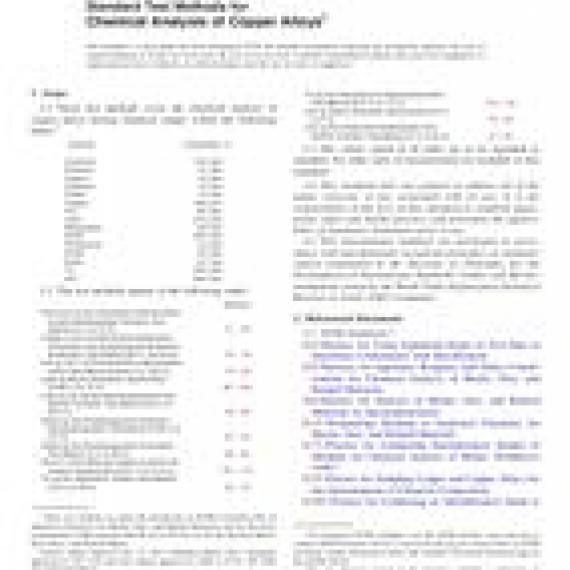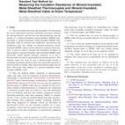No products
ASTM E478-08(2017)
ASTM E478-08(2017) Standard Test Methods for Chemical Analysis of Copper Alloys
standard by ASTM International, 01/15/2017
Full Description
1.1These test methods cover the chemical analysis of copper alloys having chemical ranges within the following limits:2
| Element | Composition, % |
| Aluminum | 12.0 max |
| Antimony | 1.0 max |
| Arsenic | 1.0 max |
| Cadmium | 1.5 max |
| Cobalt | 1.0 max |
| Copper | 40.0 min |
| Iron | 6.0 max |
| Lead | 27.0 max |
| Manganese | 6.0 max |
| Nickel | 50.0 max |
| Phosphorus | 1.0 max |
| Silicon | 5.0 max |
| Sulfur | 0.1 max |
| Tin | 20.0 max |
| Zinc | 50.0 max |
1.2The test methods appear in the following order:
| Sections | |
| Aluminum by the Carbamate Extraction-Ethyl- | 71 - 78 |
| Copper by the Combined Electrodeposition Gravimetric and Oxalyldihydrazide Spectrophotometric Test Method [50%, minimum] | 10 - 18 |
| Iron by the 1,10-Phenanthroline Spectrophotometric Test Method [0.003% to 1.25%] | 19 - 28 |
| Lead by Atomic Absorption Spectrometry [0.002% to 15%] | 90 - 100 |
| Lead by the Ethylenedinitrilotetraacetic Acid (EDTA) Titrimetric Test Method [2.0% to 30.0%] | 29 - 36 |
| Nickel by the Dimethylglyoxime Extraction Sprectophotometric Test Method [0.03% to 5.0%] | 37 - 46 |
| Nickel by the Dimethylglyoxime Gravimetric Test Method [4% to 50%] | 55 - 62 |
| Silver in Silver-Bearing Copper by Atomic Absorption Spectrometry [0.01% to 0.12%] | 101 - 112 |
| Tin by the Iodotimetric Titration Test Method [0.5% to 20%] | 63 - 70 |
| Tin by the Phenylfluorone Spectrophotometric Test Method [0.01% to 1.0%] | 113 - 123 |
| Zinc by Atomic Absorption Spectrometry [0.2% to 2%] | 79 - 89 |
| Zinc by the Ethylenedinitrilotetraacetic Acid (EDTA) Titrimetric Test Method [2% to 40%] | 47 - 54 |
1.3The values stated in SI units are to be regarded as standard. No other units of measurement are included in this standard.
1.4This standard does not purport to address all of the safety concerns, if any, associated with its use. It is the responsibility of the user of this standard to establish appropriate safety and health practices and determine the applicability of regulatory limitations prior to use.
1.5This international standard was developed in accordance with internationally recognized principles on standardization established in the Decision on Principles for the Development of International Standards, Guides and Recommendations issued by the World Trade Organization Technical Barriers to Trade (TBT) Committee.


































